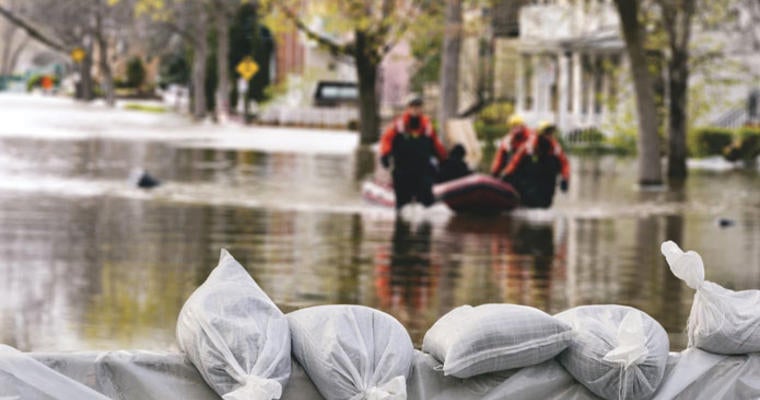No matter what kind of crisis your healthcare operation is facing, the best way to manage it is to have a solid plan.
Run-of-the-mill healthcare kitchen crises are nothing new. We deal with them almost daily. Major disasters—fire, flood, tornado, snowstorm, power outage, chemical spill, even terrorism—are thankfully not commonplace.
What should be routine, however, is a crisis-management plan. Having one in place protects the safety and well-being of your patients, residents, guests, employees and business.
Emergency plans, like disasters, come in all sizes. Government regulations at the national and local levels address basic emergency requirements, but each hospital, long-term care centre and residential community must craft its own plan to meet specific operational and regulatory needs.
In foodservice, three categories are essential: training staff to handle any situation that arises; having reserves of food and water to meet nutrition needs; and maintaining safe food handling, hygiene and service standards.
Training includes everyone
“Each crisis is unique,” says Mary Rybicki, MS, RDN, LDN, a Massachusetts-based consultant and dietitian for healthcare operations. “Complying with the rules is important, but the most important factor is being trained.”
That’s because rules vary by location. Federal rules that call for a three-day supply of nonperishable foods are superseded in Massachusetts, for example, by state rules calling for a seven-day supply. Rybicki says those distinctions help places cope when a snowstorm paralyzes traffic for days, which happened last winter in Boston. What helps even more is training. A team approach that includes dietitians, foodservice directors and other staffers allows care centres to endure weather-and other emergency-related food-delivery delays.
“Everyone on your staff needs either to be trained or have access to written instructions on how to feed people during an emergency,” Rybicki says.
Those plans include training nondietary employees to unlock the kitchen and implement a quick-start menu that can keep patients or residents fed. Written and clearly posted instructions are helpful, too, Rybicki says, especially when people are asked to perform unfamiliar roles.
“For altered, therapeutic or renal diets, proper feeding in an emergency can be a matter of life or death,” she says. “Knowing what to prepare and how to feed these patients is critical. Something as simple as having a hand grinder or mixer available to make food soft enough for patients to eat can make a difference.”
Most buildings, Rybicki notes, have backup generators for power outages, but that’s no guarantee that a kitchen will operate normally. A full freezer stays cold a long time without power. When it comes to refrigerators and appliances, know which outlets are connected to the generator, how long the generator will operate and what to do if the generator fails.
“Plan to use refrigerated foods first, before the temperature warms up beyond the 41-degree safety zone,” she says. “Label food-storage and equipment drawers; it saves energy by reducing the time you spend opening the cooler or cooking the food.”
Practice makes perfect and saves lives
Weather emergencies usually come with some warning. Fire emergencies don’t. At Fairview Lodge, a long-term care centre in Whitby, Ontario, staff training is credited with saving lives during a blaze that broke out at 9:35 a.m. on Oct. 27, 2014, ravaging a three-floor building and seven adjacent residential living areas.
“We do three fire drills per month,” says Sherry Thaxter- Smith, Director of Food Services at Fairview. “We are always practicing safe evacuation.”
Patients are told of drills and emergency plans through monthly resident council meetings. To simplify the response process, Fairview uses an emergency colour-code system. On the back of each employee’s badge is an explanation of each colour code. When the emergency coordinator declares a Code Orange, for example, the worker can quickly determine it’s a weather emergency and prepare accordingly.
“When the fire hit, we declared a Code Red and were able to evacuate all 192 residents before the fire department arrived,” Thaxter-Smith says. “Our staff moved everyone from our buildings to a nearby church; there was no hesitation because everyone was trained in what to do.”
The blaze made the Fairview kitchen inaccessible and the emergency food supply useless. But emergency training included a plan to get food from alternate sources, Thaxter-Smith says. Businesses also pitched in with food and the church evacuation site’s refrigerator kept food cold.
“Once we had everyone evacuated, we were able to retrieve dietary and medicine information from our database,” Thaxter-Smith says. “We were prepared to feed everyone about an hour after we relocated.”
By nightfall, she adds, the residents were discharged to one of 44 other sites, each with information about medical and feeding needs.
Testing the waters
At NHC Healthcare Centres in South Carolina, Regional Dietitian Jenny Dies oversees 14 skilled rehabilitation centres and four assisted-living facilities. She says training at each site involves everyone from food and nutrition services staff to laundry workers, because you never know who will be called on to act when an emergency strikes.
In addition to training, Dies conducts official reviews at each centre twice a year. The company also uses a manual that spells out a three-day cooked and noncooked meal plan. It also explains the order in which food should be used in case of a power outage.
These plans came in handy in October 2015, when torrential rains led to a flood emergency at NHC operations in Sumpter. Floodwaters surrounded a three-unit, 125-resident long-term care centre and prevented regular food delivery.
Dies said power was never lost, but two days of the three-day emergency food supply was used at one operation and a boil-water emergency was declared for four days due to a tainted municipal water supply.
Emergency planning kicked in, and the foodservice team tapped into the ½-gallon-per-resident supply of potable water. Paper plates and napkins, foam cups, and plastic utensils were used to prevent the need for dish washing.
“Dishwasher water is hot, but it’s not boiling, so disposable products are huge timesavers,” Dies said. “The one thing we didn’t anticipate was how much water we would have to boil for coffee and tea.”
Seven keys to success in case of emergency
- Food and water for three to seven days.
- Disposable dishes and utensils for three to seven days.
- Names, phone numbers and email addresses for disaster-support organizations.
- Names, numbers and email addresses for all employees.
- A contact plan, defining who will make decisions about nutrition services.
- Listing of residents’ names, room numbers, and daily food needs.
- Plan anticipating how foodservice would proceed without utilities or personnel.
Suggested Three-Day Emergency Supplies
Menu Supplies
- Assorted juices (nine meals).
- Bread, crackers, jelly (four meals and snacks).
- Graham crackers, cookies (two meals and snacks).
- Canned fruit/pudding (six meals).
- Canned chicken, tuna, salmon (two meals).
- Canned pork and beans (one meal).
- Canned pickled beets or vegetable salad (two meals).
- Puréed meats, vegetables, fruits (nine meals).
Paper Supplies
- Enough cups, plastic flatware, plates bowls, napkins, can liners, and a manual can opener and scissors for nine meals.
Special Products
- Tube-feeding supplies (three to seven days)
- Special supplements like lactose-free, renal, allergy products, thickeners, etc.
Additional Items to Consider
- Lanterns
- Flashlights
- Battery-powered radio
- Extra batteries
- Alcohol pads
- Hand sanitizer
- Food-safe disinfecting wipes
- Backup calibrated thermometers
- Matches/ lighters
- Lunch bags
- Water containers
- Hand grinder
- Hand mixer
- Markers
- Tape
- Labels

























